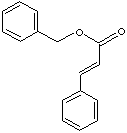PRODUCT IDENTIFICATION

CLASSIFICATION
EXTRA NOTES
FEMA No. 2142
Flavis number 9.738
PHYSICAL AND CHEMICAL PROPERTIES
34 - 37 C
AUTOIGNITION
NFPA RATINGS
REFRACTIVE INDEX
1.4025 ~ 1.4045
91 C
EXTERNAL LINKS & GENERAL DESCRIPTION
Wikipedia Linking - Cinnamic acid
Google Scholar Search - Benzyl cinnamate
Drug Information Portal (U.S. National Library of Medicine) - Benzyl cinnamate
PubChem Compound Summary - Benzyl cinnamate
KEGG (Kyoto Encyclopedia of Genes and Genomes) - Benzyl cinnamate
http://www.ebi.ac.uk/ - Benzyl cinnamate
http://www.ncbi.nlm.nih.gov/ - Benzyl cinnamate
http://toxnet.nlm.nih.gov/
Hazardous
Substances Data Bank - Benzyl cinnamate
http://cosmeticsinfo.org/i
Benzyl Cinnamate is a white to pale yellow solid or crystal substance that has a sweet balsamic odor. Benzyl Cinnamate is used as a fragrance ingredient in a wide variety of cosmetics and personal care products, including aftershaves, perfumes and colognes, skin care and hair care products.
http://www.chemicalland21.com/
Flavouring Substances Chemical Group 23 - Benzyl alcohols/aldehydes/acids/esters/acetals. Benzyl and benzoate esters included. May also contain aliphatic acyclic or alicyclic ester or acetal component.
Local:
In biological chemistry, cinnamic acid is a key intermediate in shikimate and phenylpropanoid pathways. Shikimic acid is a precursor of many alkaloids, aromatic amino acids, and indole derivatives. Phenylpropanoid are a class of plant metabolites based on phenylalanine. They are widely distributed in plants fulfilling many functions including plant defense mechanism, pigmentation and external signaling system. Phenylalanine is first converted to cinnamates, coumarines, caffeic acids, ferulic acids, and sinapic acids. Cinnamic acid is the precursor of these acids. Cinnamic acid is the parent compound of its esters which are more volatile to be transported to other parts easily. Commercial cinnamic acid, a phenylacrylic acid structure compound, is used in converting to its esters such as methyl, ethyl, and benzyl cinnamate for the perfume and flavour application. Cinnamic acid and Its derivatives including esters and carboxylic functional derivatives are used as important components in flavours, perfumes, synthetic indigo and pharmaceuticals. Cinnamate can act as optical filters or deactivate substrate molecules that have been excited by light for the protection polymers and organic substances. They, cosmetic grades, are used as sunscreen agents to reduce skin damage by blocking UV-A, B. Cinnamic acid is an odorless white crystalline powder; slightly soluble in water; melting point 133 C and boiling point 300 C. Benzyl Cinnamate is a common used flavoring agent (sweet, floral, fruity) and used as a perfumery fixer.
APPEARANCE
PURITY
98.5% min
1 max (mg KOH/g)
HAZARD OVERVIEW
May cause eye and skin irritation. May cause respiratory and digestive tract irritation.
RISK PHRASES
SAFETY PHRASES
24/25